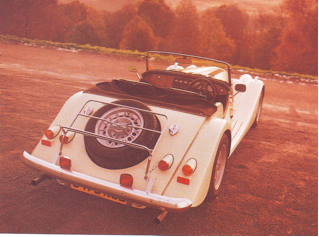1954 Morgan
As government regulations threaten to engineer much of the character out of modern cars, as our roads become more congested and dangerous and the air we breathe gets more contaminated, we can look back to the "classic" era of the 1950's and 1960's as the romantic Golden Age of the motor car. In Europe, more and better mass-produced cars were seen as a liberating force for families previously restricted to public transport.
In north America, cars simply got bigger, reflecting the wealth and confidence of the most powerful nation on earth. Traffic was yet to reach its often grid-locked state of today, petrol was much cheaper and, in Britain at least, there were no speed restrictions on the newly-opened motorways.
1954 Morgan
Before the mergers and close-downs of the 1970's, buyers could choose from a far wider range of makes reflecting national identities. The Japanese motor industry, later so dominant, was not even a speck on the horizon in the 1950's and 60's. In engineering and styling, too, cars tended to be more varied and individual - you could tell an Austin from a Morris, a Vauxhall from a Volvo, without having to look at the badge. Safety was optional: it was speed, glamour and style that sold cars, and in the 50's and early 60's nobody had even begun to think of the exhaust-emission regulations that would strangle power outputs in the 70's. Back then, the motor car was our servant. Now, through its very proliferation, it has become our master.
Dave Clarkson in his 1954 Morgan
The Wooden-framed Plus 8 was in continuous production for 36 years, always powered by the venerable lightweight alloy Rover V8 engine. It's also one of the only cars in which the passenger compartment actually gets bigger in a frontal impact. Not that you'd want to find that out...!
1954 Morgan interior
With a 150bhp high-compression V8 (Rover P5B spec), it's an astonishingly accelerative device, as fast to 90mph as a contemporary Porsche 911. Only 850kg to shift, and brilliant handling, at least on smooth roads, the tail gives about half an hour's warning before it breaks free.
1954 Morgan rear view
Yes, it's made using antique methods, with steel and/or aluminium panels wrapped around an ash frame. This means Mogs don't last as well as all-steel cars; like a thatched roof, they need 'doing' every couple of decades, especially if wet and rot have penetrated.
1954 Morgan at the Centenary Car Club show
When supplies of the 2138cc Triumph four-cylinder engine dried up in the late 60's, Morgan were left without a high-performance engine for their flagship Plus 4 model. Help was on the horizon, in the form of Rover's all-alloy 3.5-litre V-eight derived from a discarded Buick design of the early 60's and recently introduced in the big P5B saloon and coupé. Light, compact and powerful (165bhp) it was ideal for the job and transformed the Morgan into a real road-burner: top speed leapt to more than 120mph (193kph) with stunning rapid acceleration matched by very few road cars. Renamed the Plus 8, it looked at first glance identical it its predecessor, but in fact, had a slightly longer wheelbase and wheel track and subtly difference body contours. The most obvious change was the light alloy wheels but, underneath, the sliding pillar front suspension and leaf-sprung live rear axle remained - along with the rock-hard vintage-style ride.
1954 Morgan at the Centenary Car Club show
It was an immediate success, with more than 4000 built to date, though never at a rate of more that 15 per week. Steel bodywork was standard - with ash framing, of course - but there was an optional sports light-weight version from 1975. Early cars used the noisy, old-fashioned Moss gearbox familiar on Jaguar saloons, but from 1972, the Rover-four-speed transmission was used.
Fuel injection was introduced in 1984 and rack-and-pinion steering in 1986. The latest cars have a 3.0litre version of the Rover engine, giving 190bhp.
As with the 4/4, demand for this anachronistic car remains healthy, with a waiting list of several years.
But if you want the best of British and the deep-chested appeal loved by Bentley Boys and Spitfire pilots, it's the only choice.
There's a lively owners' club and the factory that originally built all 6233 Plus 8's is still going strong.
Morgan 1968-2004 Specifications
Engine : 3528cc V8
Power : 160-190bhp
Top Speed : 124mph 0-60mph : 6.7sec
Fuel Consumption : 21mpg
Transmission : 4-5 speed
No. built : 4,000 plus
Morgan Plus 4 (1954) Specifications
ENGINE :4-Cyl CAPACITY : 1172-1599cc
POWER : 36-96bhp
TRANSMISSION : 3/4/5-speed
TOP SPEED : 75-110mph (120-177kph)
NO BUILT : 6,803 up to 1991
- Info from 'The World Encyclopedia of Cars' by Martin Buckley and Chris Rees
.








0 comments:
Post a Comment